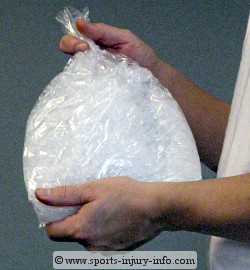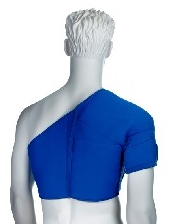RICE - The First Steps
Rest, ice, compression, and elevation, commonly reffered to as RICE, is the first and best treatment for all your sports injuries. Believe it or not, the treatment that you undertake within the first 24 hours following an injury can literally cut weeks off of your total recovery time.No one wants to suffer from a sports injury, but more than likely, at some point they are bound to happen. Following the RICE principles will speed your recovery, and get you back into the game faster. And that is the ultimate goal with sports injuries. To fully understand why RICE works, lets look a bit closer at each of the different elements.
Rest
Rest is the first principle of RICE. Rest does not necessarily mean total immobilization, or weeks on crutches. However, it is important, especially within the first 24-48 hours following injury. Whether you have suffered a sprain or a strain, the actual injury involves tearing of either muscle, tendon, or ligament fibers.Your body's first reaction is to begin the repair process by stopping the bleeding at the site of injury. It does this by forming a clot around the injured tissues. This fibrin clot is very fragile, and rest is important to allow for both the clot formation, as well as preventing disruption of this clot after it is formed.
Once the clot is formed, your body immediately starts to repair the damaged tissue. Initially, a scar matrix is formed of very weak fibers. Good formation is generally achieved in just a few days. So following the RICE principles and resting that ankle sprain helps to protect the damaged tissue while your body starts the repair process.
Ice
There are many therapeutic properties of ice. First off, it cools the injured area, and creates a numbing type of effect. This is handy in reducing pain, and making things feel a little bit better. Ice provides pain relief by slowing down the transmission of pain signals along the nerves from the injured area to the central nervous system.While pain relief is beneficial following injury, the most important function of ice has more to do with its effects on the actual cells in the injured area. This can get a bit complicated, so stay with me...

This is achieved by reducing the need for oxygen. Ice has a cooling effect, and in turn, reduces the metabolism of the cooled tissues. This reduced metabolism decreases the need for oxygen. Cells that would normally die because of a lack of oxygen can now survive. Preventing excessive secondary tissue death is the number one reason that ice should be used immediately following an injury, and why it is an important part of RICE.
How to use ice
Compression
Compression is the most important part of the RICE principles. Applying some type of compressive wrap to an injured area can greatly reduce the amount of initial swelling. Swelling is a major factor in prolonged rehabilitation. Swelling will occur very rapidly, however, it takes a much longer to get rid of it. It has to be removed through the lymph system, and this is a very slow, passive process.Compression helps to control swelling by not allowing extra fluid to pool in the spaces between the cells. Above, I told you about secondary tissue death, which is primarily caused by swelling. So it stands to reason that if you have less swelling, then you will have less secondary tissue death. I cannot stress enough how important the compression component of RICE is following an injury. For example...
Lets say we have two ankle sprains, both having the same amount of initial damage. One is left without compression, while the other is wrapped within the first hour after injury. The compressed ankle sprain will have much less overall swelling, and will most likely have a rehab time that is 1-2 weeks shorter than the sprain that wasn't treated with compression. When you are talking about a high school season that only lasts for 10-12 weeks, 2-3 weeks more in rehab can make a huge difference. So please, don't forget the C in RICE.

A compression wrap applied underneath the ice decreases the cooling effect, and ice applied under the compression wrap reduces compression.
There is an answer though, and one that I highly recommend. It is a ice compression wrap. Comprised of a cold gel pack encased in a fabric wrap, it allows you to ice and compress a body part, and is the perfect way to apply the R.I.C.E. principles.
Every single ACL reconstruction patient that I see at the clinic is given an ice compression wrap - and these run around $160.00. Not cheap...however it works wonders on sore muscles and acute injuries.
Elevation
Elevation is the final component of the RICE principles. It simply refers to keeping the injured body part in a position higher than or equal to the level of the heart. For an ankle sprain, this would mean propping your foot up while lying down or sitting.Elevation works on a simple premise. Gravity. Gravity pulls things down, and this is especially true with swelling. Remember, swelling is removed through the lymph system. This passive system can be greatly aided when gravity is taken out of the picture. So while you are resting to protect that newly formed clot and scar matrix, and are icing and using a compression wrap, keep that injured part elevated.
What about heat?
If you have noticed, all of the RICE principles are primarily used to help control swelling. In the world of sports injuries, swelling is the biggest obstacle for recovery. Swelling causes pain, because it increases the pressure in the area, specifically the pressure on nerve endings. It restricts range of motion. And swelling even decreases strength by causing muscles to shut down. As swelling decreases, pain levels decrease, range of motion increases, and muscular strength improves. RICE addresses swelling in the best ways possible.The reason you apply heat to an area is to increase
blood flow. This is not a good idea in an acute injury. Increased blood
flow causes more fluid to move into an area, which can result in more
swelling.
This is completely opposite of the RICE principles. Strike
one.Increased temperatures cause an increase in metabolism, and an increased need for oxygen. Remember, the tissues surrounding an injury are already starved for oxygen, and so applying heat can cause more secondary tissue death. Again, not in line with RICE. Strike two.
While applying heat to an injured area will no doubt feel much better than applying ice, using heat too soon following injury can increase rehabilitation times, and prolong your return to play. Strike three.
Four Letters to Live By
Ask any physician, certified athletic trainer, or other sports medicine professional and they will all tell you the same. RICE is the best thing you can do immediately following an injury. So the next time you twist that ankle during a basketball game, follow the RICE principles immediately, and start your recovery out on the right foot.Didn't find what you were looking for? Search SII for more information...
Running Pain Solutions
Written for Runners by a runner, you'll learn a holistic approach to improving mobility, restoring normal movement and muscle activation patterns, and restoring the body and mind connection.
This Kindle Book contains a step by step program to keep you running pain free. Included are detailed instructions and illustrations for exercises to improve mobility, balance, neuromuscular control, strength and endurance. Only $7.49!
Get Your Copy Today!









